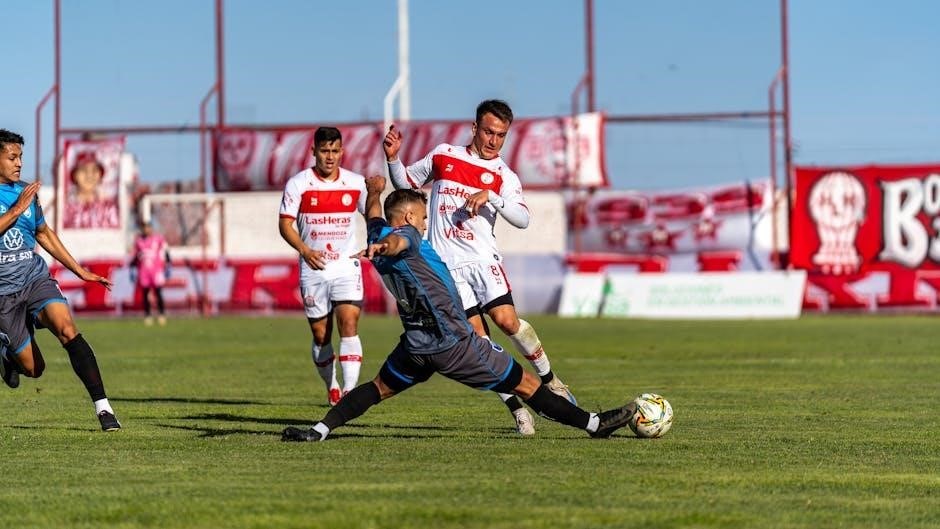A well-structured soccer conditioning program enhances endurance, speed, agility, and strength, preparing players for the physical demands of the game while reducing injury risks.
1.1 Importance of Soccer Conditioning
Soccer conditioning is vital for optimizing performance, as it enhances endurance, speed, agility, and strength. It prepares players for the sport’s high physical demands, ensuring they can maintain intensity throughout matches. A well-designed program reduces injury risks by improving muscle stability and flexibility. Conditioning also boosts mental focus and resilience, enabling players to outperform opponents. Incorporating drills that combine fitness with skill work maximizes efficiency, making it essential for both amateur and professional athletes. By addressing aerobic and anaerobic needs, soccer conditioning ensures players are physically and mentally ready to excel on the field.
1.2 Overview of a Soccer Conditioning Program
A soccer conditioning program is a structured plan designed to enhance players’ physical abilities and prepare them for the demands of the sport. It typically includes phases such as preseason, in-season, and off-season training, each with specific goals. The program combines endurance, speed, agility, strength, and flexibility exercises to improve overall fitness. Workouts may involve high-intensity interval training, fartlek runs, shuttle runs, and skill-based drills. The program is tailored to address the sport’s aerobic and anaerobic requirements, ensuring players can sustain performance over 90 minutes. Regular conditioning also helps prevent injuries and enhances mental focus. Consistency and proper guidance are key to achieving optimal results and elevating gameplay.

Key Components of a Soccer Conditioning Program
A soccer conditioning program consists of endurance training, speed and agility drills, strength and power development, and flexibility exercises to enhance overall athletic performance effectively.
2.1 Endurance Training
Endurance training is a cornerstone of any soccer conditioning program, focusing on building both aerobic and anaerobic capacity. It involves exercises like steady runs, interval training, and fartlek drills to improve stamina. High-intensity workouts, such as 100m repeats and 30/30 intervals, push players to their limits, enhancing their ability to recover quickly. Additionally, longer runs at a moderate pace increase overall cardiovascular fitness, preparing players for the sustained effort required over 90 minutes. A well-structured endurance program ensures players can maintain intensity throughout the game, reducing fatigue and improving performance. Incorporating varied workouts keeps the training dynamic and prevents plateaus, ensuring continuous progress. Consistency in endurance training is key to building a robust physical foundation for soccer.
2.2 Speed and Agility Drills
Speed and agility drills are essential for soccer players to enhance quick movements and sharp changes of direction. Exercises like ladder drills, shuttle runs, and figure-8 cone setups improve acceleration and deceleration. These drills focus on rapid footwork, balance, and coordination, allowing players to explode out of turns and maintain control. Incorporating short bursts of sprinting and dynamic movements mimics game scenarios, preparing players for the fast-paced nature of soccer. Consistency in these drills ensures players can outmaneuver opponents and maintain peak performance throughout the match. Proper form and technique are emphasized to maximize effectiveness and prevent injuries. Agility training is a vital component for any player aiming to elevate their speed and responsiveness on the field.
2.3 Strength and Power Development
Strength and power development are crucial for soccer players to build muscle, enhance explosiveness, and improve overall performance. Exercises like squats, lunges, and deadlifts target key muscle groups, while plyometric drills, such as box jumps and burpees, boost power. Resistance band workouts and medicine ball throws also contribute to core strength and stability. A well-structured program ensures players can deliver powerful kicks, sprint with force, and maintain dominance in physical battles on the field. Proper form and progressive overload are essential to maximize results and prevent injuries. This component of conditioning helps players gain a competitive edge, enabling them to excel in high-intensity moments during matches. Consistency in strength training translates to greater durability and effectiveness over the course of a season.
2.4 Flexibility and Mobility Exercises
Flexibility and mobility exercises are essential for soccer players to maintain range of motion, prevent muscle imbalances, and reduce injury risk. Dynamic stretching, such as leg swings and high knees, prepares muscles for activity. Static stretches, like hamstring and hip flexor stretches, improve flexibility after workouts. Mobility drills, including yoga or Pilates, enhance joint movement and core stability. Incorporating foam rolling and self-myofascial release helps relieve muscle tension. A consistent flexibility routine ensures players can perform at their best, with improved agility and coordination on the field. Regular mobility work also supports long-term athletic development and overall physical health. These exercises are often overlooked but are vital for peak performance and durability in soccer.

Structured Soccer Conditioning Workouts
Structured soccer conditioning workouts are organized in phases, focusing on preseason, in-season, and off-season training. These workouts combine endurance, strength, and agility drills to prevent injuries and enhance performance.
3.1 Preseason Conditioning Program
A preseason soccer conditioning program is designed to build a strong foundation for the upcoming season; It typically lasts 6-8 weeks, focusing on increasing endurance, strength, and agility through high-intensity workouts.
3.2 In-Season Maintenance Workouts
In-season maintenance workouts are crucial for sustaining fitness levels without causing burnout. These workouts are less intense than preseason programs, focusing on maintaining endurance, strength, and agility. They typically include a mix of aerobic and anaerobic exercises, such as steady runs, interval training, and dynamic stretching. The goal is to preserve the physical conditioning achieved during the preseason while adapting to the demands of regular matches. Coaches often incorporate skill-specific drills to ensure players stay sharp and injury-free. Proper recovery techniques, such as light cardio and mobility exercises, are also emphasized to maintain performance consistency throughout the season.

Benefits of a Well-Designed Conditioning Program
A well-structured conditioning program improves performance, prevents injuries, and enhances endurance, ensuring players maintain peak physical fitness and consistency throughout the season. It boosts stamina and overall athletic capabilities.
4.1 Improved Performance on the Field
A well-designed soccer conditioning program significantly enhances a player’s ability to perform at their best. By focusing on endurance, speed, agility, and strength, players can sustain longer periods of intense effort, recover faster between plays, and maintain consistent performance. Improved endurance allows for prolonged stamina, enabling players to contribute effectively throughout the entire match. Enhanced speed and agility enable quicker sprints, sharper turns, and better positioning on the field. Strength development contributes to more powerful kicks, stronger tackles, and better overall physicality. These improvements collectively result in a more dynamic and impactful performance, giving players a competitive edge. Conditioning also enhances mental toughness, helping players stay focused and composed under pressure. The result is a more confident, capable, and effective athlete.
4.2 Injury Prevention
A well-structured soccer conditioning program plays a crucial role in preventing injuries. By strengthening muscles, improving flexibility, and enhancing mobility, players reduce their risk of common injuries such as hamstring strains, ACL tears, and shin splints. Proper conditioning ensures muscles and joints are prepared for the demands of the game, reducing the likelihood of overuse or acute injuries. Additionally, a focus on balance and stability drills helps improve coordination, further minimizing injury risks. A conditioning program also promotes proper recovery techniques, such as stretching and hydration, which are essential for maintaining overall player health. By prioritizing injury prevention, players can enjoy a safer and more consistent season. Regular conditioning fosters resilience and helps athletes perform at their best while staying injury-free.

Creating a Soccer Conditioning Program PDF
A well-designed PDF program includes essential drills, schedules, and guidelines, ensuring clarity and usability for players and coaches to achieve optimal soccer fitness and performance.
5.1 Essential Elements to Include
A soccer conditioning program PDF should include structured workouts, endurance drills, speed and agility exercises, strength training routines, and flexibility practices. It must outline weekly schedules, progression plans, and nutritional advice. Visual aids like diagrams and charts enhance clarity. Including warm-up and cool-down routines ensures safety and recovery. Progress tracking sheets help monitor improvement. Clear instructions and safety guidelines are crucial for proper execution. The PDF should also address injury prevention and rehabilitation techniques. Organized formatting with sections for preseason, in-season, and off-season phases ensures usability. Including sample drills and variations caters to different fitness levels, making the program adaptable and comprehensive for all players.
5.2 How to Format for Clarity and Usability
Formatting a soccer conditioning program PDF requires a structured and visually appealing layout. Use clear headings, subheadings, and bullet points to organize content. Include tables or charts for workout schedules and progress tracking. Add high-quality images or diagrams to illustrate exercises and drills. Ensure proper spacing and font sizes for readability. Highlight key sections like warm-ups, cool-downs, and nutritional advice using bold or italic text. A table of contents at the beginning helps navigate the document easily. Use page breaks to separate major sections, and include a glossary for unfamiliar terms. Finally, save the PDF in a universally compatible format and ensure it’s mobile-friendly for easy access on devices.



0 Comments